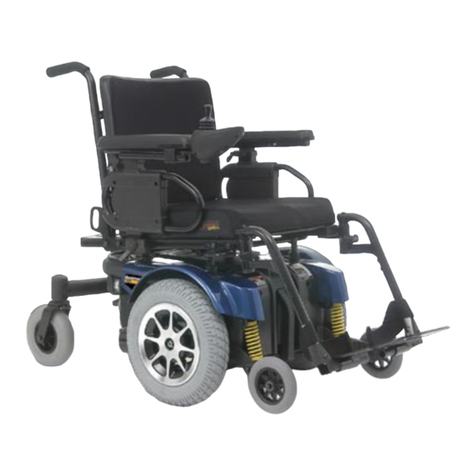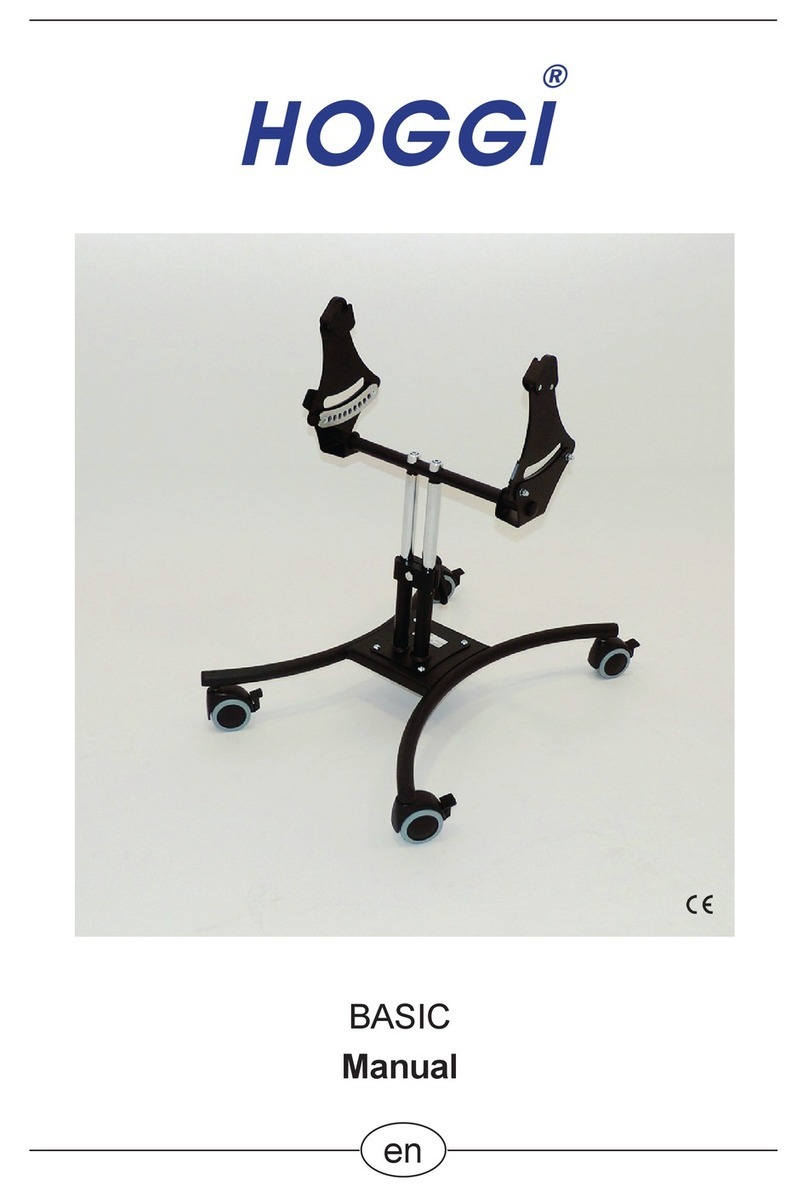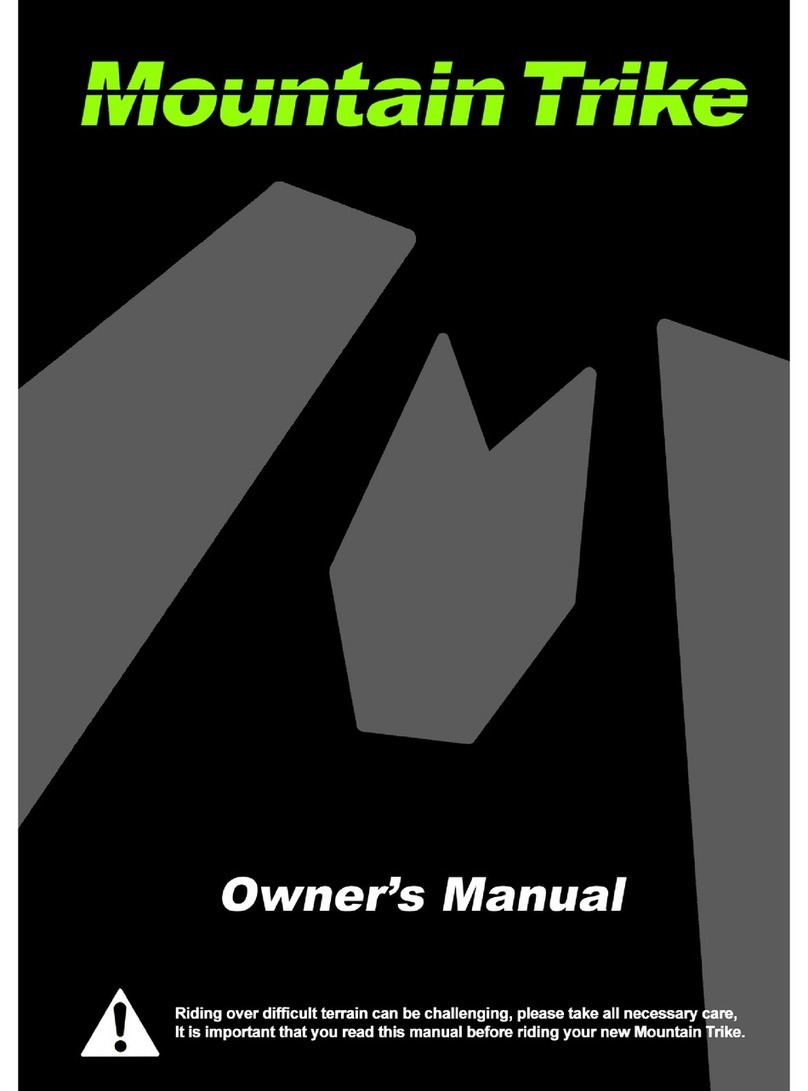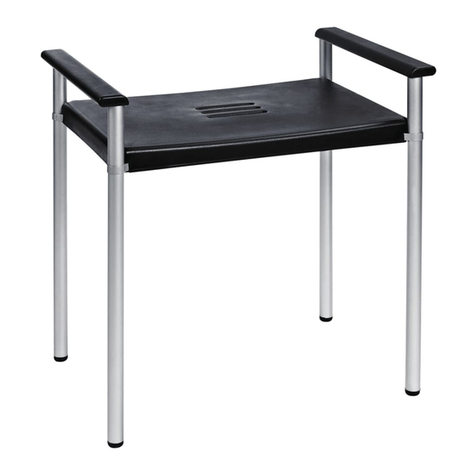I-GO Crest CSS User manual

PAGE 1
USER MANUAL
CareCo (UK) Ltd, Hubert Road, Brentwood, Essex, CM14 4JE
by

PAGE 2
27
CONTENTS
1. PREFACE AND INTRODUCTION
2. SAFETY NOTICE
2.1 Before driving
2.2 While driving
3. EMI
4. PARTS INTRODUCTION
5. OPERATION
5.1 Control panel
5.2 Operating your power chair
5.3 Adjusting the seat
5.5 How to set to freewheel mode
5.6 Circuit breakers
6. BATTERY CHARGING AND CARE
6.1 Battery
6.2 Charging the battery
7. INSPECTION AND MAINTENANCE
7.1 Inspection
7.2 Regular checking record
7.3 Battery, fuse and tyre
7.4 Storage
8. TROUBLE SHOOTING AND SPECIFICATION
9. WARRANTY DECLARATION
1
2-6
2
3-6
10
10
13
15
16
16
21
22
22
23
17
17
7-8
9
10-16
17-20
21-23
24-26

PAGE 1
1. PREFACE & INTRODUCTION
Please carefully read this owner’s manual before using the power chair. Improper use of
This owner’s manual includes operating instructions for every aspect of the power chair,
including assembly instructions and how to deal with possible accidents.
»The symbols used in this manual are explained below:
Read carefully the notes marked with these symbols:
»This manual includes a repair and maintenance record chart and warranty
information. Please keep it in a safe place.
»If someone else uses the power chair, please make sure that you provide them with
the instruction manual for their consideration.
»
illustrations and pictures in the manual may not correspond to the power
chair that you have purchased.
Power Chairs have been designed and manufactured to provide a comfortable, secure
Warning Improper usage could result in serious injury or death
Attention Improper usage could lead to injury and/or damage
to your power chair.
Suggestion Follow these instructions to keep your power chair in good
operating order.

PAGE 2
2. SAFETY NOTICE
2.1 BEFORE DRIVING
The user needs to be familiar with the operation of this power chair before driving.
Therefore please always keep the following safety notices in mind.
The same trac rules apply to the use of this power chair as apply to pedestrians
For your safety, please therefore follow the rules that apply to pedestrians.
»Drive on the pavement, single carriage roads, or pedestrian areas only.
Never drive on motorways or dual carriageways.
»Please do not drive your power chair after consuming alcohol
or when you are tired.
»Please be careful when driving your power chair in low light. It has
not been designed for use at night.
»The power chair may only be used on the pavement or pedestrian
areas at 4mph.
Practice operating your power chair
Before using the power chair in busy or potentially dangerous areas, familiarize yourself
with the operation of your power chair. Practice in an open area like a park. In order to
driving motions, such as accelerating, stopping, turning, reversing, driving up and down
ramps.
»Please turn the speed dial to value 1 for your initial practice.
»Be sure someone accompanies you for safety when driving on the roads for the
»
operate and control your power chair.
The Crest CSS Power Chair is only to be used by one person at a time
Do not carry passengers on your power chair. (including children)
Do not use this power chair to carry or haul goods
»
under “MAX LOAD WEIGHT”

PAGE 3
2. SAFETY NOTICE
2.2 WHILE DRIVING
Carry out daily inspections.
Refer to the section titled “DAILY CHECKING”
Do not move your body out of the power chair while moving
»Such action may cause you to lose balance and risk injury from falling.
»Ensure you wear suitable clothing that won’t get tangled in the wheels
Do not use your power chair under any of the circumstances below.
»
snow-covered, icy, or on canal towpaths not protected by any fence or hedge.
Keep away from places where you might get the wheels stuck.
»Do not drive at night or when it is raining or snowing, misty or windy.
»Do not drive your power chair in an “S” pattern or make erratic turns.
»Do not take the power chair onto escalators.
»UNDER NO CIRCUMSTANCES SHOULD THE POWER CHAIR BE USED AS A SEAT ON
MOVING TRANSPORT (E.G. CARS, BUSES, TRAINS, ETC).
Mobile Phones and other electrical equipment
»Do not use a mobile phone or other wireless communication
device while driving.
»
before using a mobile phone.
»Do not charge the mobile phone or any other electrical device
from the power chair battery.
»Do not use this power chair to carry or haul goods.
Automatic Power Shut Down
automatic power shut down facility. If the power chair is turned on, it will automatically
once again.

PAGE 4
2. SAFETY NOTICE
Ramps, inclines and drops
»
Refer to the section entitled “CLIMBING ANGLE” in Specications.
»Always use a low speed setting when ascending or descending a gradient.
»Do not drive on roads with large drops or potholes. Refer to the section entitled
»Slow down when driving on roads with inclines.
»Do not make sudden turns when driving on gravel roads or ramps.
»Always lean forward when climbing a steep gradient.
Starting and Driving
1. Make sure the seat is installed properly.
2. Fold down the armrests to enable use.
3. Turn the power on.
4. Check battery indicator to see whether there is enough power for your journey.
If you have any doubt about the remaining power, recharge the batteries before
departure.
5. Set the speed dial to a position with which you feel safe and comfortable.
6. Check the joystick lever works correctly.
7. Make sure the electromagnetic brake works correctly.
8. Make sure it is safe around you before you drive onto the street.
Warning!
»Do not set in freewheel mode when driving on a gradient.
»Always re-engage the anti-freewheel device before use.
Fail to do so may result in injury
»Always fasten the seat belt when operating the power chair.
»
electromagnetic brake system will activate while driving down a steep
gradient. This will limit the speed to a safe level. Turn the power on
again to re-start your power chair.
»Maximum User Weight Limit Refer to section titled “MAX. LOAD WEIGHT“
in Specications. Overloading past the weight limit may lead to damage of
your power chair or cause it to malfunction and will endanger your own
safety. The warranty does not cover this type of damage.

PAGE 5
2. SAFETY NOTICE
Attention
1. Avoid putting all of your weight on the footrest. This may cause the
power chair to tip resulting in injury.
2. Do not turn the power switch to OFF while driving as this will lead to
an emergency stop and possible risk of accident and injury.
3. Do not set to the higher speeds while driving indoors.
4. Do not adjust the speed dial while driving; a sudden change in speed may
cause danger to you and others, and may damage your power chair.
5. Do not place magnetic devices near the area of the controller as this could
6.
7. While reversing the power chair, beware of people or objects behind you.
Attention
»When climbing an incline, do not zigzag or drive at an angle up the face of
the incline.
»Always drive your power chair straight up the incline.
»This greatly reduces the possibility of a tip or a fall.
»Always exercise extreme caution when negotiating an incline.
»Never travel up or down an incline that can be potentially hazardous
(for example, areas covered with snow, Ice or cut grass).
Stopping
Release the joystick control lever completely. The power chair will naturally
brake and stop.
Driving on the pavement
to travel at more than 4 mph on the pavement.

PAGE 6
2. SAFETY NOTICE
Inclines and uneven terrain
When climbing an incline, try to keep your power chair moving. If you must stop, start
up again slowly and then accelerate cautiously. When driving down an incline, do so
slowly and in the forward direction only. If your power chair starts to move faster than
you anticipated or desired it would, allow the chair to come to a complete stop by
releasing the joystick. Push the joystick slightly forward and continue travelling slowly
down the incline.
Maximum recommended incline
The Crest CSS Power Chair has undergone extensive incline testing. Our results show
that the maximum incline it can safely climb is 6 degrees at maximum weight capacity.
6 degrees is the angle of most disabled access ramps. Any attempt to climb a steeper
slope may make your Crest CSS unstable.

PAGE 7
3. EMI
This section provides the user with basic information that describes the problems with
electromagnetic interference (EMI), known sources of EMI, protective measures to either
lessen the possibility of exposure or to minimize the degree of exposure, and suggested
action should unexpected or erratic movement occur.
Attention
It is very important that you read this information regarding the possible
Attention
Some mobile telephones and similar transmit signal while they are ON, even
when not being used.
Electromagnetic Interference (EMI) from radio wave sources
Power chairs may be susceptible to electromagnetic interference (EMI), which is
interfering electromagnetic energy (EM) emitted from sources such as radio stations,
TV stations, amateur radio (HAM) transmitters, two-way radios, and mobile phones.
The interference (from radio wave sources) can cause the power chair to release its
brakes, move by itself, or move in unintended directions. It can also permanently
damage the powered wheelchair’s control system. The intensity of the interfering EM
energy can be measured in volts per meter (V/m). Each power chair can resist EMI up
to certain intensity; this is called its “immunity level”. The higher the immunity level, the
greater the protection. At this time, current technology is capable of achieving at least a
20 V/m immunity level, which would provide useful protection from the more common
sources of radiated EMI. This power chair model has an immunity level of 20 V/m
without any accessories.
everyday environment. Some of these sources are obvious and easy to avoid. Others
are not apparent and exposure is unavoidable. However, we believe that by following
the guidelines listed below your risk to EMI will be minimized.
1. Hand-held portable transceivers (transmitter-receivers with the antenna mounted
directly on the transmitting unit. Examples include: citizens band (CB) radios, “walkie
communication devices.
2.
trucks, ambulances and taxis. These usually have the antenna mounted on
the outside of the power chair.

PAGE 8
3. EMI
3. Long-range transmitters and transceivers, such as commercial broadcast
transmitters (radio and TV broadcast antenna towers) and amateur (HAM) radios.
Attention
Other types of hand-held devices, such as cordless phones, laptop
computers, AM/FM radios, TV sets, CD players, and small appliances such
as electric shavers and hair dryers are not, so far as we know, likely to
cause EMI problems to your power chair.
Power Chair Electromagnetic Interference (EMI)
Because EM energy rapidly becomes more intense as one moves closer to the
(transceivers) are of special concern. It is possible to unintentionally bring high levels
of EM energy very close to the control system of the power chair while using these
listed below are recommended to prevent possible interference with the control system
of the power chair.
Warnings
1. Do not operate hand-held transceivers-receivers, such as citizens band (CB) radios,
or turn ON personal communication devices such as mobile phones, while the
power chair is turned ON.
2. Be aware of nearby transmitters such as radio or TV stations, and try to avoid
coming close to them.
3. If unintended movement or brake release occurs, turn the power chair OFF as
soon as it is safe;
4. Be aware that adding accessories or components, or modifying the power chair,
may make it more susceptible to EMI (Note: There is no easy way to evaluate
5. Report all incidents of unintended movement or brake release to the power
chair manufacturer, and note whether there is a source of EMI nearby.
Important Information
1. 20 Volts per meter (V/m) is a generally achievable and useful immunity level
against EMI (the higher the level, the greater the protection);
2. This product has an immunity level of 20 V/m without any accessories and
connected to it.

PAGE 9
4. PARTS INTRODUCTION
1
2
3
4
5
6
7
8
9
1. Joystick Controller
2. Armrest
3. Seat back
4. Seat
5.
6. Drive Wheel
7. Caster Wheel
8. Footrest
9. Battery Box
Parts Description

PAGE 10
5.1 CONTROL PANEL
Your Crest CSS is operated by a joystick and controller
Control Functions
1. Battery Gauge
2. ON/OFF Button
3. Horn Button
4.
5.
6. Joystick
5.2 OPERATING YOUR POWER CHAIR
Battery Gauge
The battery gauge shows you that the power chair is switched on. It also indicates the
operating status of the power chair
ON/OFF Button
The ON/OFF button applies power to the control system electronics, which in turn
supply power to the power chair’s motor.
Do not use the ON/OFF button to stop the power chair unless there is an emergency.
5. OPERATION
1
2
3
4
6
5
Attention
If you use the ON/OFF button to stop the power chair, it may shorten
the life of the drive components

PAGE 11
Speed Dial
Turn this dial to determine to the speed range of the power chair. Turn the dial
anti-clockwise to go slower and clockwise to go faster.
Horn Button
Press either button to sound the horn.
Joystick
The primary function of the joystick is to control the speed and direction of the power
chair. The further you push the joystick from the center position the faster the power
chair will move. When you release the joystick the brakes are automatically applied.
Joystick Depth Adjustment
enables you to move the joystick from the armrest to the desired position.
5. OPERATION

PAGE 12
5. OPERATION
Suggestion
1. You should recharge the batteries after each time the power chair is used
to ensure maximum range. The batteries should be charged at least once a
week even if the power chair is not used.
2. After charging or replacing a new battery, drive the power chair for
3. In winter, the battery may respond more slowly and the battery range
may be reduced.
4. When driving on a gradient, the battery indicator light might move up
and down. This is normal and should not cause concern.
5. Even with proper care and use of the battery it is natural for the battery’s
capacity to reduce with time. Therefore, when the battery’s range has
reduced by about 50% from when it was new, it is time for it to be replaced.
Please contact your dealer about replacement batteries. If an old battery
continues to be used it can lead to a rapid decline in performance.
6.
7. The batteries have a six-month warranty covering manufacturing
defects. This warranty does not cover faults due to incorrect
battery recharging.
Braking
Electro-magnetic brake: Release the speed control lever completely, and the
electromagnetic brake will be activated automatically, and the power chair will stop.
Warning
When on a gradient NEVER switch the power chair to freewheel mode. The
electromagnetic brakes will not be applied and this may result in injury.

PAGE 13
To adjust the armrest angle:
5.3 ADJUSTING THE SEAT
To adjust the armrest width:
5. OPERATION
1. Loosen the knobs.
2. Slide the armrests in or
out to the desired width.
3. Tighten the knobs.
knobs
To adjust the height of armrests:
1. Lift up the armrest.
2. Loosen the hex nut.
3. Adjust the socket screw up or down
to the desired arm angle position.
4. Tighten the hex nut.
5. To determine the same angle for
the opposite armrest, count the
exposed threads after the hex nut
has been tightened.
6. If necessary, repeat the steps for
the opposite armrest.
1. Loosen knob on handle.
2.
3. Tighten knob.
Hex
Knob Armrest

PAGE 14
To remove the seat:
1. Turn the power OFF.
2. Make sure the Crest CSS is not in
freewheel mode.
3. Push the seat rotate lever while
pulling up on the seat to remove.
To change the seat height:
1. Remove seat (See “To remove the Seat”)
2. Remove the shroud.
3. Disengage and remove the seat height adjustment pin from the seat post.
4. Remove the height adjustment pin from each of the four posts.
5. Raise or lower each post to the desired position.
6. Reinstall the seat height adjustment pin through the seat post and armrest post.
(Bend the end of the pin lock and position it over the end the pin.)
7. Reinstall the shroud.
8. Reinstall the seat.
9. Plug the connectors into the electronics tray.
To rotate the seat:
1. Turn the power OFF.
2. Make sure the Crest CSS is not in
freewheel mode.
3. Pull the seat rotate lever while
pulling up on the seat to rotate.
5. OPERATION
Seat Rotate Lever

PAGE 15
5.4 ADJUSTING THE FOOTREST
5. OPERATION
To adjust the footrest angle:
You can adjust the angle of the footrest with a hex wrench (M6).
1. Loosen the screw under the footrest.
2. Adjust hex nut to set the footrest angle, and then tighten the screw.

PAGE 16
5.5 HOW TO SET TO FREEWHEEL MODE
you to disengage the drive motors and manoeuvre the chair manually.
To engage the drive and take the power chair out of freewheel:
1. Turn the freewheel lever to “DRIVE” position (left and right).
2. Activation of the joystick automatically releases the brake so the powered
Crest CSS can be driven.
To disengage the drive and place the power chair in freewheel:
1. Turn the freewheel lever to “NEUTRAL” position (left and right).
5. OPERATION
5.6 CIRCUIT BREAKERS
The Power Chair has a circuit breaker protruding through the shroud cover at the right
of the power chair.
Warning
Do not use your Crest CSS Power Chair while the drive motors are
disengaged unless you are in the presence of an attendant! Do not
disengage the drive motors when on an incline as the power chair may
roll down, causing injury!
Suggestion
back and forth; the lever should then move to the desired position.
»In the unlikely event of a short circuit
or heavy overload ,all power to the
»To reset , depress the circuit breaker
before the circuit breaker will reset.
»If the power chair continues to shut
down after resetting, have it serviced
by a dealer.

PAGE 17
6.1 BATTERY
»The Crest CSS Power Chair uses two long-lasting, 12 volt, deep-cycle batteries.
These batteries are sealed and maintenance free. Since they are sealed, there is
handle a longer and deeper discharge. Though they are similar in appearance to
automotive batteries, they are not interchangeable. Automotive batteries are not
designed to handle a long, deep discharge and are unsafe for use in
power chairs.
»
»Do not expose the battery to temperatures below -10°C or above 50°C when
charging or storing the power chair. Outside the above temperature range can
cause the battery either to freeze or overheat, causing damage and shortening
its life.
6. BATTERY CHARGING & CARE
6.2 CHARGING THE BATTERIES
The battery charger is essential in providing long battery life. Located underneath the
utility tray, it is designed to optimize your Crest CSS’s performance by charging safely,
tray for easy viewing. The ammeter indicates the rate of charge being administered to
fully recharge the batteries. It is also a good indication of whether or not the charger
is working. The ammeter and the charger are only functional when the charger power
cord is plugged into a wall outlet.
Warning
Battery posts, terminals and related accessories contain lead and lead
compounds. Wash hands after handling!
Use proper batteries
»Your power chair operates on two 12 volt batteries.
»They should be a minimum of 20 ampere hour rating. Only deep
cycle sealed case construction batteries should be used in the power chair.
»When you buy a replacement, insist on a deep cycle sealed case. Do not use
any other type.

PAGE 18
6. BATTERY CHARGING & CARE
Charging the batteries on-board using the charger
»Position the power chair next to a
standard wall outlet.
»Be certain the controller power
»Connect the charging cable into
the charging socket.
»Plug the charging cable into the
wall outlet.
»We also recommend that the
batteries are not charged for
more then 24 hours.
»When your batteries are fully
charged, unplug the charging
cable from the wall outlet.
»Disconnect the charging cable
from the Crest CSS.
Charger
Warning
1.
explosion of battery.
2. Do not smoke while charging as the battery may release hydrogen gas.
Always charge the battery in a well-ventilated space.
3. Avoid electric shock! Never connect or disconnect the plug or cord with wet
hands while charging. Do not connect or disconnect the plug or cord when
they are wet.
Attention - Please follow the rules below to avoid accidents while charging.
1. Please use the manufacturer’s supplied charger only, and recharge the
battery to its full capacity every time. You may damage the battery and power
2. Please charge in a well-ventilated space not directly exposed to sunlight.
Do not charge in areas that are humid or exposed to rain, mist nor dew.
3. Do not charge in temperatures -10°C or higher than +50°C as the charger
may not work well and the batteries could be damaged.
Table of contents
Other I-GO Wheelchair manuals
Popular Wheelchair manuals by other brands
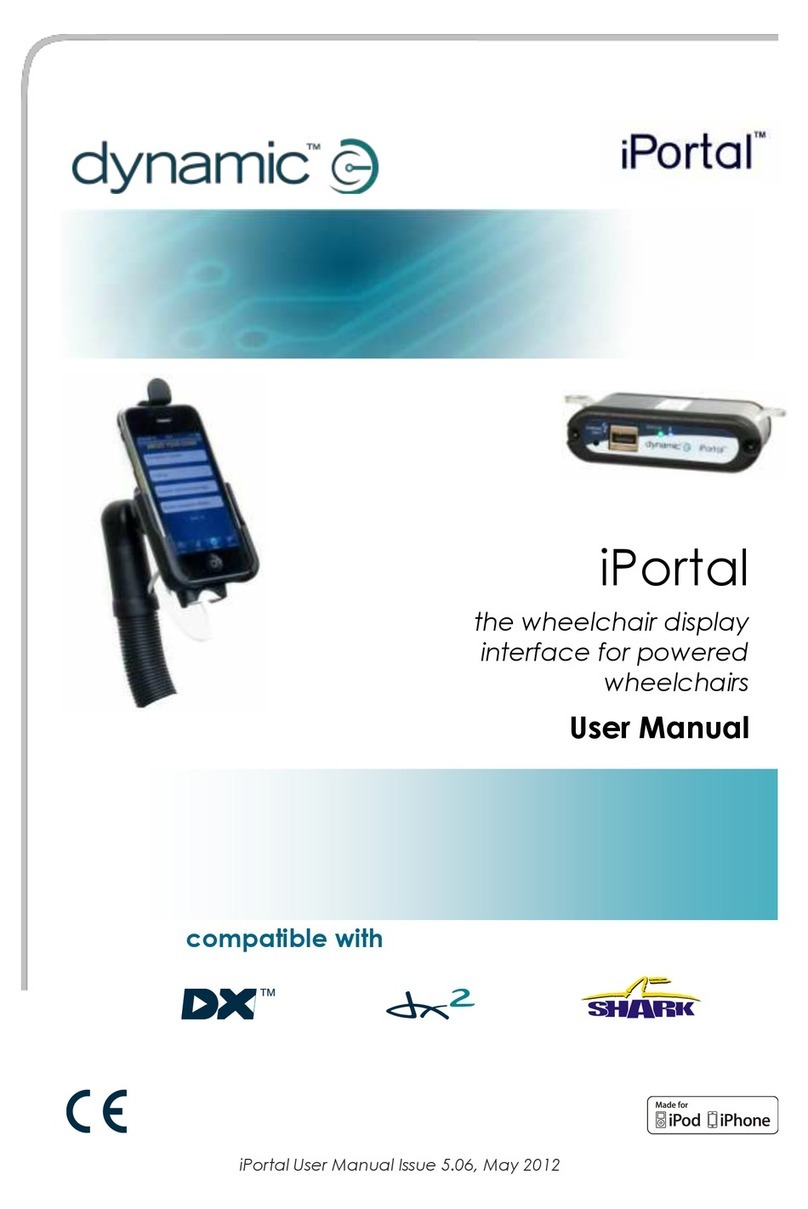
Dynamic
Dynamic iPortal user manual
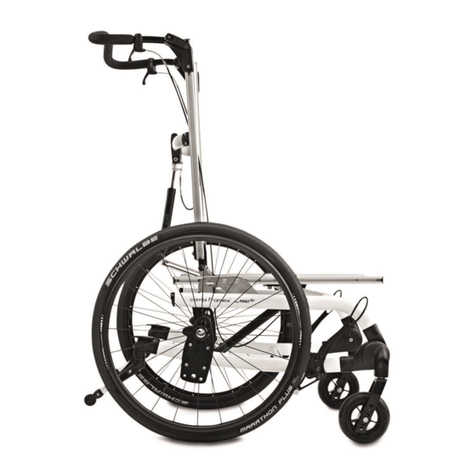
R82
R82 Multi Frame:x user guide

Drive Medical
Drive Medical Travelite Chair In A Bag Owner's handbook
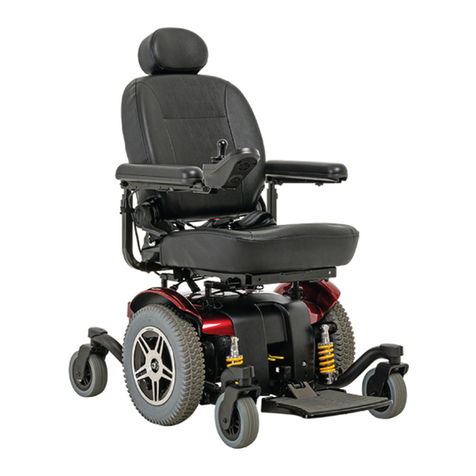
Pride
Pride JAZZY 614 series owner's manual

Invacare
Invacare Eliminator? Owner's operator and maintenance manual

DiscountRamps
DiscountRamps Silver Spring ESC400 instructions

CAMOBIL
CAMOBIL Pantom instruction manual
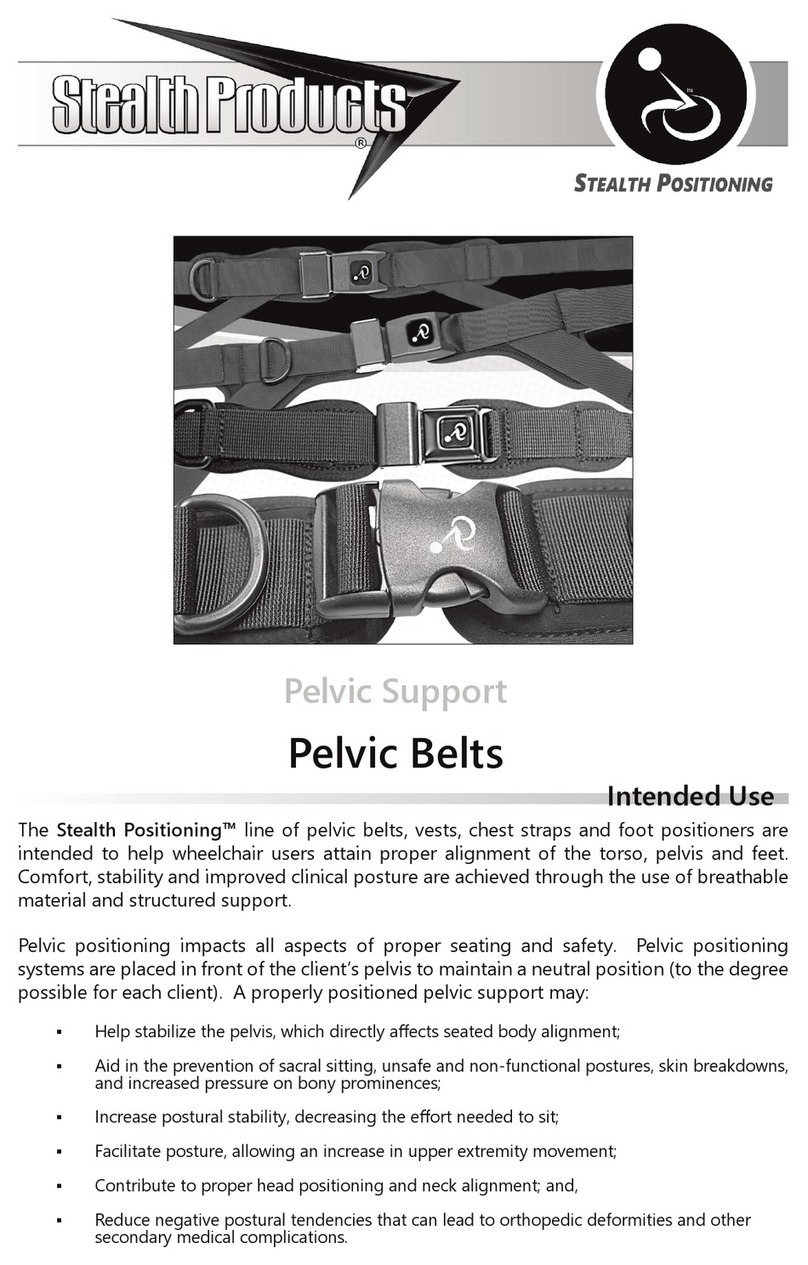
Stealth Products
Stealth Products Stealth Positioning Pelvic Belts manual
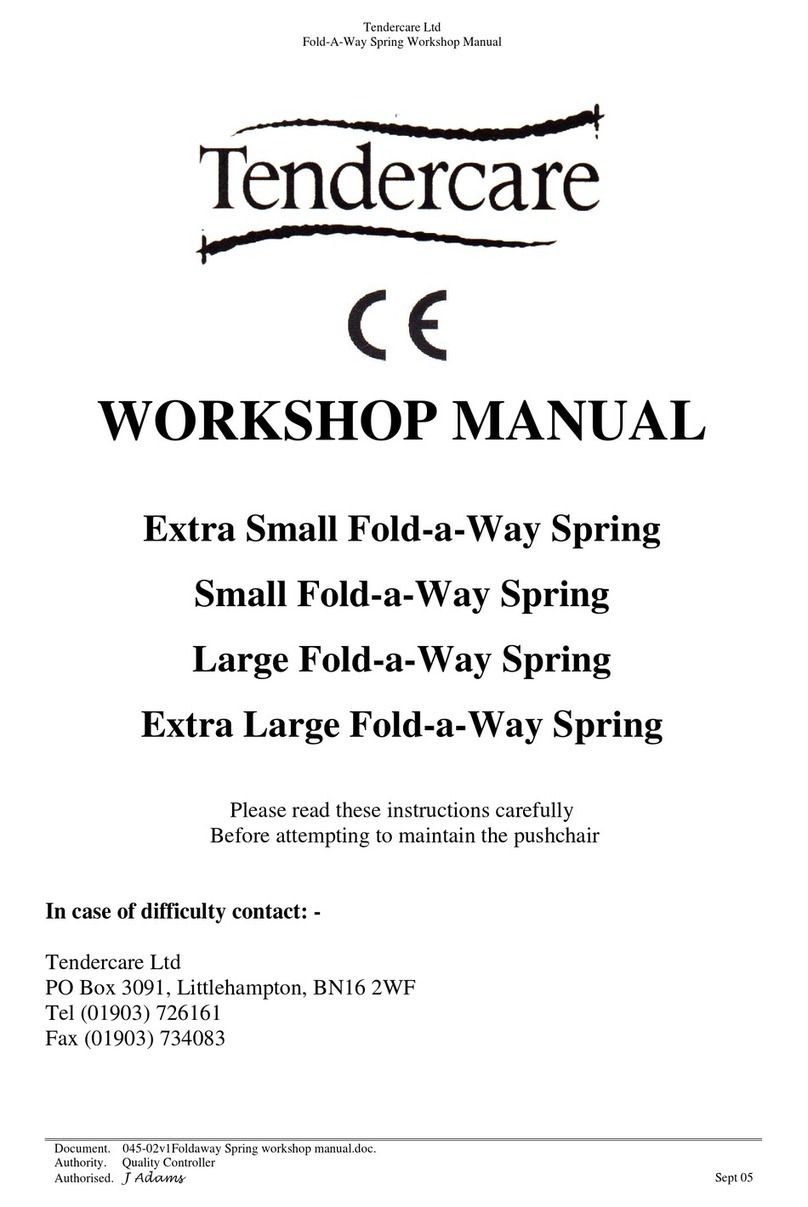
Tendercare
Tendercare Extra Small Fold-a-Way Spring Workshop manual
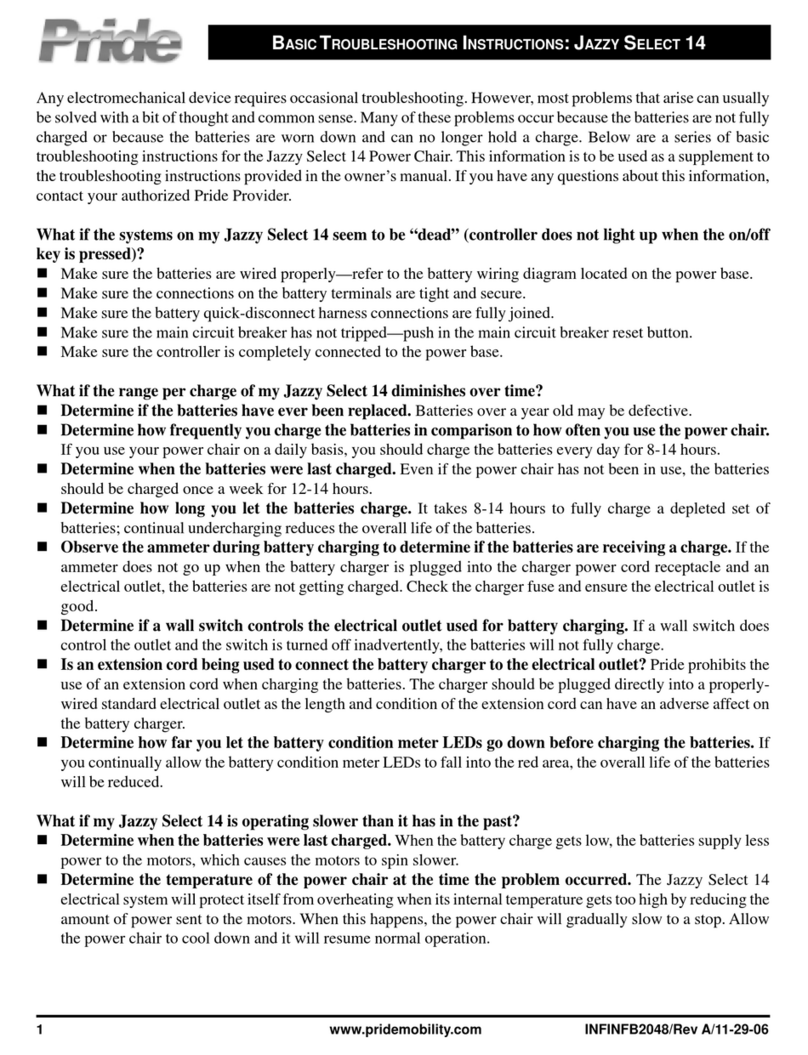
Pride
Pride Jazzy Select 14 INFINFB2048 Troubleshooting instructions

Sanction Industry
Sanction Industry MF-5630 instruction manual
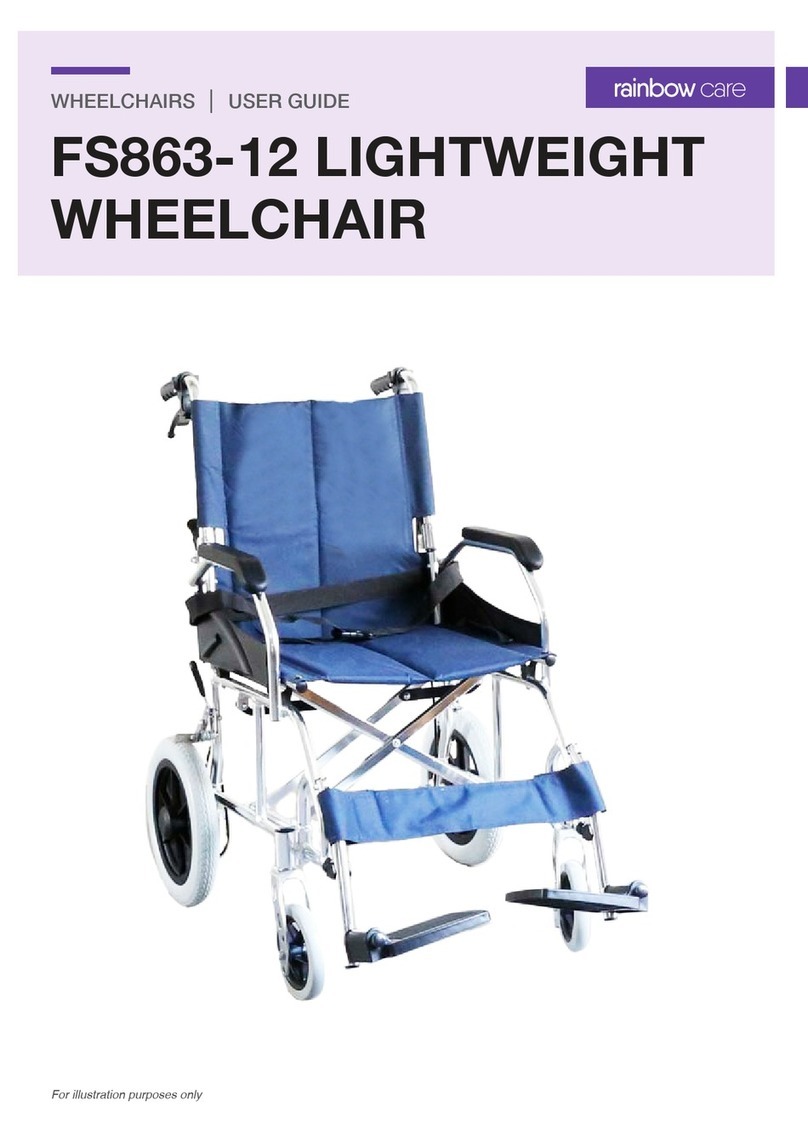
Rainbow
Rainbow FS863-12 user guide


